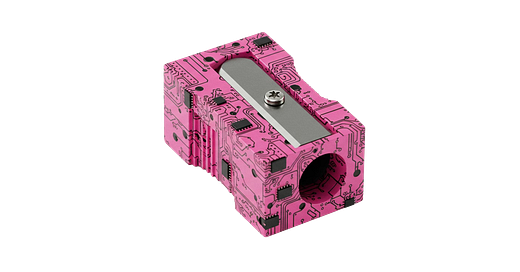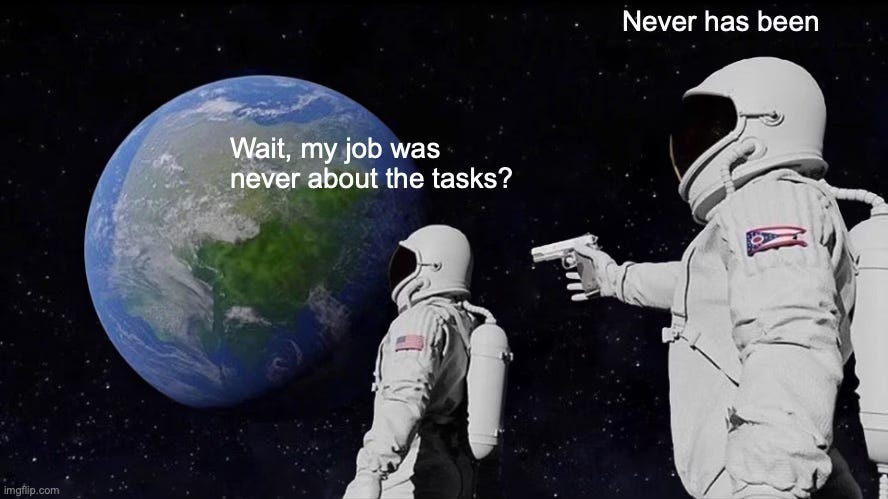Half your job was never your job
Why AI taking your tasks might be the best thing that happens to you
Last week, a lawyer friend texted me in a panic: “Just saw AI can review contracts in seconds. Am I obsolete?”
I texted back: “Why do you think they hired you?”
“To review contracts?”
“Really? That’s why clients pay you $500 an hour? To read documents?”
The silence stretched long enough that I knew he was getting it. They hired him to keep them out of trouble. To spot dangers they can’t see. To be the calm voice when everything goes sideways. The contract review? That's just how he did the job. It was never the job itself.
This question—why do you think they hired you?—is the most important one you can ask. Because the professionals who can’t answer it are the ones watching their phones go quiet.
To understand how AI changes your job, you first need to understand why your job exists at all.
The rise of AI is splitting professions. Machines take over the task half, while humans still shine in the outcome, the half that truly matters. I call this the Job Split.
Jobs to be Done
People don’t hire lawyers to review contracts; they hire lawyers to protect them from catastrophic mistakes. They don’t hire teachers to deliver information; they hire teachers to transform their children into capable adults.
This is the “Jobs to be Done” framework: the idea that we hire professionals not for their tasks but for the outcomes they deliver. Tasks are just the means. Outcomes are the actual job. This distinction is exactly why AI transforms rather than replaces professional work.
AI is phenomenal at tasks. It can review a thousand contracts, grade a million tests, or analyse (almost) infinite data points. But can it protect you from a catastrophic business decision? Can it inspire a struggling student to believe in themselves? Can it hold your hand when the diagnosis is cancer?
This gap between what AI can do (tasks) and what humans are actually hired for (outcomes) is creating the biggest career transformation in history.
The Job Split Framework
Every profession is being divided along these four dimensions. I call it the “Job Split” because AI creates a fundamental divide: tasks drift away while the human core remains. Then it transforms the existing role into something more powerful. Think of it like a pencil being sharpened. The wood shavings fall away, but what remains is more precise, more focused, more effective at its actual purpose.
1. Drop
What goes to AI? The specific tasks AI absorbs. Spoiler: These were never why people hired you anyway.
2. Defend
What remains human? The skills requiring genuine human connection, creativity, or judgment. Where the real “job” lives.
3. Elevate
How the role evolves with AI. How freed time redirects toward higher-value human work—less time on tasks, more time on the actual job.
4. Reinvent
New hybrid roles. Entirely new positions emerging at the intersection of human expertise and AI capability.
Let me show you how this splits three professions in radically different ways.
Lawyers: Hired to Prevent Disaster, Not Process Paper
Remember my panicked lawyer friend? His profession perfectly illustrates how the Job Split works.
Why we hire lawyers: To navigate risk, protect interests, and sleep soundly knowing someone smart has our back when stakes are high.
Drop: Document review, legal research, case summaries, billing entries, routine filings, standard compliance checks.
Defend: Reading a jury’s mood at 3 pm on a Friday. Crafting creative legal strategies no one’s tried. Being the calm voice when a client’s world falls apart. Making ethical calls in grey areas where precedent fails.
Elevate: AI saves lawyers hours weekly, generating hundreds of thousands in new billable time annually. But firms sticking to hourly billing are discovering they’ve been selling the wrong thing. Smart firms are shifting to value pricing—clients never wanted billable hours. They wanted peace of mind. AI isn’t dulling legal practice; it’s sharpening it to a fine point.
Reinvent:
Here are some new jobs that might emerge thanks to the job split.
Legal AI Orchestrators will manage armies of digital associates that never sleep, never miss a precedent, and can analyse every contract a company ever signed in seconds (while occasionally hallucinating, yes). One person will command and oversee the legal firepower of a hundred.
Algorithmic Justice Auditors, with the task to ensure AI systems used in courts don’t perpetuate bias, while combining legal expertise with technical understanding to challenge automated decisions.
Digital Rights Architects will design legal frameworks for virtual worlds, smart contracts, and AI entities, writing laws for realities that don’t yet exist.
Preemptive Risk Modellers will use AI to simulate thousands of legal scenarios before deals close, identifying catastrophic edge cases human lawyers might miss.
Teachers: Hired to Transform Minds, Not Transfer Information
Google can deliver information. YouTube teaches skills. But transforming a child into a capable adult? That's purely human territory.
Why we hire teachers: To inspire curiosity, build character, and help young humans discover what they’re capable of becoming.
Drop: Grading multiple choice tests, creating standard lesson plans, delivering basic content, and administrative paperwork.
Defend: Noticing when a usually chatty student goes quiet. Sparking that "aha!" moment through perfect timing. Managing 30 different personalities in one room. Being the adult who believes in a kid when no one else does.
Elevate: Teachers are evolving from information deliverers to learning experience designers. Imagine knowing exactly where each of 150 students struggles, supported by AI that adapts to every learning style. That’s not replacement. That’s superpowers.
Reinvent:
Imagine these roles in the future.
Learning Experience Architects design educational journeys that respond to each student in real time, creating 30 different paths to the same understanding.
Cognitive Development Choreographers blend neuroscience with pedagogy, using AI to track brain development patterns and optimise learning windows for each child.
Virtual Reality Learning Directors create immersive historical experiences where students don’t just read about Rome: they walk through it, with AI managing thousands of interactive elements.
Emotional Intelligence Coaches use AI emotion recognition to help students understand their feelings, but provide the human wisdom to navigate them.
Translators: The Canary in the AI Coal Mine
Last month, a translator friend told me she hadn’t received a new client inquiry in six weeks. Not six days. Six weeks.
This isn’t just another profession getting disrupted. It’s the warning signal for everyone else.
Why we hire translators: To bridge human understanding across cultures, capture nuance that matters, and ensure nothing critical gets lost in translation.
But here’s what’s actually happening:
Drop: Word-for-word translation, basic document conversion, simple website localisation, routine business correspondence.
Defend: High-stakes diplomatic translation where one word could start a war. Literary translation capturing an author’s soul. Legal translation where precision prevents lawsuits. Cultural bridge-building in sensitive negotiations.
Elevate: The middle market isn’t just shrinking. It’s evaporating. When AI output satisfies 80% of clients at 5% of the cost, the phone stops ringing. Survivors aren’t competing on speed or price. They’re becoming Cultural Intelligence Architects, navigating where language, culture, and context create complexities that are hard for AI to untangle.
Reinvent:
Localisation Strategists orchestrate AI translation systems while catching cultural landmines, like why that “perfect” translation is actually offensive in Thailand.
Cultural Intelligence Architects don’t just translate words; they translate intentions across cultures, ensuring a Japanese “maybe” is understood as “no” in New York (I so hope I am not triggering anyone here! I might need a cultural intelligence advisor myself).
Diplomatic Communication Engineers manage real-time AI translation in international negotiations while monitoring for dangerous misunderstandings before they escalate.
Narrative Preservation Specialists use AI to document dying languages while ensuring cultural stories maintain their power across linguistic boundaries.
The Pattern Across All Professions
The same transformation is happening everywhere: from medicine to marketing, engineering to journalism. Each profession faces its own version of the split, but the pattern remains consistent.
Here’s how it plays out across different fields:
The Universal Pattern: Tasks vs. Jobs
After analysing these professions, the pattern is clear. AI consistently takes:
data processing and pattern recognition,
documentation and administrative tasks,
repetitive and rule-based work,
scaling standardised services.
While humans retain monopoly on:
emotional intelligence and empathy,
creative problem-solving,
trust-building and relationships,
navigating ambiguity and ethics.
AI gets the tasks. Humans keep the jobs. Like a pencil sharpener removing excess wood to reveal the graphite core, AI strips away the tasks to reveal what we’re actually hired to do.
Find Your Human Edge
Step 1: Define Your Real Job. What are people actually hiring you to do? Not your tasks; your outcome. Write it in one sentence. This is your North Star (or Southern Cross).
Step 2: Audit Your Task Portfolio. List everything you do in a typical week. Mark each as “AI-vulnerable” or “Human-essential.”
Step 3: Calculate Your Shift Percentage. What percentage of your time goes to AI-vulnerable tasks? Be honest. It's probably higher than you think. If clients can get “good enough” from AI, you need to move fast.
Step 4: Identify Your Fortress. What do you do that requires genuine human connection, creativity, or judgment? These are your career anchors.
The Choice Architecture of Career Transformation
Here’s what I told my lawyer friend after his moment of panic: “You’re not becoming obsolete. You’re being offered a choice. You can either cling to tasks that AI does better, or you can embrace what makes you irreplaceably human: your ability to read a room, craft creative arguments, and be the calm in someone's legal storm.”
This is the difference between disruption and irrelevance. Disruption splits your job. Irrelevance erases it.
The data is definitive: 170 million new jobs will emerge by 2030, versus 92 million displaced. That's a net gain of 78 million opportunities. But they won't look like today's jobs. They will be roles we're just beginning to imagine.
The professionals commanding premium positions aren’t fighting AI. They’re dancing with it. They understand that their real job was never about the tasks; it was about the outcomes only humans can deliver.
Your job isn’t disappearing. It’s being sharpened. The question is: Will you embrace the process or fight to keep the shavings?
Over to you
What’s your profession’s real "job to be done"?
How are you seeing the split happen in your field?
I read every response, and the best insights might make it into my next piece.






Marek, let me challenge your point a bit. I agree, that we are hired not to do the tasks. But your point is also that, let’s say, the real human understands what to say in this or that situation to drive the outcome. I’ve read an article on psychology today, and they point out that in many cases patients say, that the answers from AI were more compassionate than from a real psychologist. The link is below. https://www.psychologytoday.com/us/blog/urban-survival/202504/artificial-intimacy-and-empathy-does-authenticity-matter